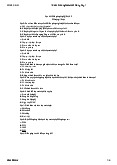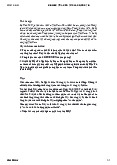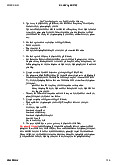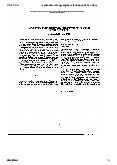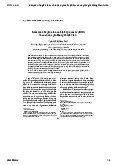



















Preview text:
17:44 31/7/24 English Syntax-To Minh Thanh about:blank 1/211 17:44 31/7/24 English Syntax-To Minh Thanh
ÑAÏI HOÏC QUOÁC GIA THAØNH PHOÁ HOÀ CHÍ MINH
TRÖÔØNG ÑAÏI HOÏC KHOA HOÏC XAÕ HOÄI & NHAÂN VAÊN Toâ Minh Thanh TAØI LIEÄU OÂN THI
TUYEÅN SINH SAU ÑAÏI HOÏC CHUYEÂN NGAØNH Giaûng daïy tieáng Anh
(Taùi baûn laàn thöù nhaát, coù chænh söûa)
NHAØ XUAÁT BAÛN ÑAÏI HOÏC QUOÁC GIA
TP HOÀ CHÍ MINH – 2008 about:blank 2/211 17:44 31/7/24 English Syntax-To Minh Thanh CONTENTS
Content................................................................................................................................ i
Preface.............................................................................................................................. vii
Outline for revision............................................................................................................ ix
Table of notational symbols ........................................................................................... xii Section one: WORD CLASSES
1 Parts of speech, word classes and grammatical categories ............................... 1
2 Classification of word classes ......................................................................... 2
2.1 Major classes vs. minor classes ................................................................... 2
2.2 English major classes ................................................................................... 3
2.2.1 English form classes ...................................................................... 4
2.2.2 English positional classes .............................................................. 6
2.3 English minor classes ................................................................................. 10
2.4 Word-class exercises ............................................................................... 10
2.4.1 Exercises for form classes........................................................... 10
2.4.2 Exercises for positional classes................................................... 12
Section two: TYPES of PHRASES, CLAUSES and SENTENCES
3 Phrases vs. clauses............................................................................................... 15
4 Adjective phrases vs. adverb phrases ............................................................... 15
5 Attributive vs. predicative adjectives/adjective phrases .................................. 17
6 Noun phrases vs. verb phrases ........................................................................... 18
7 The N-bar (N’) as a level of NP-structure that is intermediate
between the phrasal (NP) level and the lexical (N) level ................................ 20
8 Types of pre-nominal modifiers........................................................................... 21
8.1 Determiners .............................................................................................. 21
8.2 Quanyifying adjectives ............................................................................. 23
8.3 Adjective phrases ..................................................................................... 26
8.4 Pre-modifying nouns .................................................................................. 27
8.5 Possessive common nouns ......................................................................... 28 i about:blank 3/211 17:44 31/7/24 English Syntax-To Minh Thanh
8.6 Verb participles ........................................................................................ 29
8.7 Gerunds ..................................................................................................... 30
8.8 Restricters ................................................................................................ 31
9 Types of post-nominal modifiers......................................................................... 32
9.1 Prepositional phrases ................................................................................. 32
9.2 Adjective phrases ...................................................................................... 33
9.3 Participial phrases ..................................................................................... 35
9.4 Infinitive phrases ...................................................................................... 35
9.5 Subordinate adjective clauses .................................................................. 36
10 Noun complements vs. optional post-nominal modifiers .................................. 36
11 Classification of English verbs/verb phrases ................................................... 38
11.1 Intensive verbs/verb phrases ................................................................. 39
11.2 Complex transitive verbs/verb phrases .................................................. 40
11.3 Ditransitive verbs/verb phrases ............................................................. 43
11.4 Monotransitive verbs/verb phrases ........................................................ 47
11.5 Prepositional verbs/verb phrases ........................................................... 51
11.5.1 Monotransitive Prepositional verbs/verb phrases ................... 51
11.5.2 Ditransitive Prepositional verbs/verb phrases ........................ 53
11.6 Intransitive verbs/verb phrases ............................................................. 55
11.7 Summary of the classification of English verbs/verb phrases ............. 57
11.8 Troublesome verbs ................................................................................... 59
12 Types of clause links .......................................................................................... 61
13 Types of clauses................................................................................................. 62
13.1 Finite clauses vs. non-finite clauses ........................................................ 62
13.2 Independent clauses vs. dependent clauses ........................................... 63
13.3 Subordinate clauses vs. embedded clauses ............................................ 64
14 Covert subjects vs. overt subjects .................................................................. 66
15 Types of finite dependent clauses .................................................................... 67
15.1 Nonimal clauses ........................................................................................ 67
15.2 Relative clauses ........................................................................................ 67 ii about:blank 4/211 17:44 31/7/24 English Syntax-To Minh Thanh
15.3 Adverbial clauses ..................................................................................... 68
15.4 Reporting clauses ..................................................................................... 68
15.5 Comment clauses ...................................................................................... 68
16 Types of non-finite clauses .............................................................................. 69
16.1 Infinitive non-finite clauses .................................................................... 69
16.2 Gerund non-finite clauses ........................................................................ 69
16.3 Participial non-finite clauses ................................................................... 70
16.4 Verbless clauses ....................................................................................... 71
17 Classification of sentences according to their structures ............................. 71
17.1 Simple sentences ...................................................................................... 71
17.2 Compound sentences ................................................................................ 72
17.3 Complex sentences ................................................................................... 72
17.3.1 Embedded nominal clauses .............................................................. 73
17.3.1.1 As the subject ...................................................................... 73
17.3.1.2 As the direct object/the predicator complement ............ 78
17.3.1.3 As the indirect object ........................................................ 89
17.3.1.4 As the subject(ive) complement .......................................... 90
17.3.1.5 As the object(ive) complement ........................................... 91
17.3.1.6 As the complement of a preposition .................................... 94
17.3.2 Subordinate/embedded adjectival clauses .................................... 95
17.3.3 Subordinate/embedded adverbial clauses ..................................... 96
17.4 Compound-Complex sentences ................................................................. 97
Section three: GRAMMATICAL RELATIONS
18 Structure .......................................................................................................... 99
19 Endocentric structures vs. exocentric structures ...................................... 99
20 Types of syntactic structures ........................................................................ 100
20.1 Structures of modification ................................................................... 100
20.2 Structures of complementation ............................................................ 101
20.3 Structures of coordination .................................................................... 101
20.4 Structures of predication ..................................................................... 103 iii about:blank 5/211 17:44 31/7/24 English Syntax-To Minh Thanh
21 Constructions vs. constituents ........................................................................ 104
22 Immediate constituents vs. ultimate constituents ........................................ 104
23 Immediate constituents of a sentence ........................................................... 105
24 Intervening level of organization between word and sentence ..................... 106
25 Modifiers vs. complements............................................................................... 106
26 Types of adjective complements...................................................................... 108
27 Pre-adjectival modifiers vs. post-adjectival modifiers ................................. 108
28 Adjective complements vs. optional post-adjectival modifiers .................... 109
29 Classification of English adjectives according to their post-modifiers............ 111
30 Types of adverbial adjuncts ............................................................................. 112
31 Noun phrase analyses ....................................................................................... 123
32 Mis-diagraming.................................................................................................. 125
33 Structural ambiguity in English noun phrases................................................. 126
33.1 Define a structurally ambiguous noun phrase .......................................... 126
33.2 Explain structurally ambiguous noun phrases ........................................... 128
33.3 Disambiguate structurally ambiguous noun phrases................................. 134
33.4 Account for structurally non-ambiguous noun phrases ........................... 138
34 Verb phrase analyses.................................................................................. 140
34.1 Noun phrases as the sP/sC of an intensive verb or as the dO of
a monotransitive verb ............................................................................. 140
34.2 NP direct objects of a monotransitive verb or NP adverbial
adjuncts of an intransitive verb.............................................................. 141
34.3 Prepositional phrases as the sP/sC of an intensive verb or as
the optional adverbial adjunct of a
ny verb ............................................ 142
34.4 IntransVAC vs. intransV—Adv .............................................................. 143
34.5 MonotransVAC—NP vs. intransV—PP .................................................... 144
34.6 MonotransVAC—NP vs. monotrans-prepV—prepO ............................... 146
35 Sentence analyses ....................................................................................... 147
35.1 Identify the syntactic function of a PP ................................................... 147
35.2 Decide whether a PP is part of the complementation of a
ditransitive verb ..................................................................................... 148 iv about:blank 6/211 17:44 31/7/24 English Syntax-To Minh Thanh
35.3 Explain the difference between two sentences ...................................... 151
35.4 Re-analyse sentence pairs, using tree-diagrams .................................. 154
36 Structural ambiguity in English verb phrases ................................................ 157
37 Phrase structure............................................................................................... 162
37.1 Definition ................................................................................................. 162
37.2 How to determine phrase structure? ..................................................... 162
37.2.1 Substitution .............................................................................. 162
37.2.2 Conjoinability ............................................................................. 165
37.2.3 Movement .................................................................................. 166
37.2.4 Checking the antecedent for a pro-form ................................ 167
37.3 Phrase structure exercises .................................................................... 167
38 Phrase structure rules ..................................................................................... 170
39 Surface structures vs. deep structures ......................................................... 172
40 Signals of syntactic structures ....................................................................... 174
40.1 Word order .............................................................................................. 174
40.2 Function words ......................................................................................... 174
40.3 Inflection ................................................................................................. 175
40.4 Derivational contrast .............................................................................. 176
40.5 Prosody .................................................................................................... 176
41 What is syntax? ............................................................................................... 177
Section four: SAMPLE TESTS IN ENGLISH LINGUISTICS ................................178
Bibliography ...................................................................................................197 v about:blank 7/211 17:44 31/7/24 English Syntax-To Minh Thanh LÔØI NOÙI ÑAÀU
Thöïc teá laø khoâng phaûi saùch ngoân ngöõ cuûa taùc giaû ngöôøi nöôùc ngoaøi naøo
cuõng ñaùp öùng ñuùng vaø ñuû noäi dung oân taäp thi tuyeån sinh sau ñaïi hoïc chuyeân
ngaønh Giaûng daïy tieáng Anh (Teaching English to Speakers of Other Languages)
theo quy ñònh cuûa Tröôøng Ñaïi hoïc Khoa hoïc Xaõ hoäi vaø Nhaân vaên, thuoäc Ñaïi
hoïc Quoác gia Thaønh phoá Hoà Chí Minh. Taøi lieäu naøy ra ñôøi nhaèm ñaùp öùng nhu
caàu oân taäp thi tuyeån sinh sau ñaïi hoïc cho moân Ngöõ hoïc trong chuyeân ngaønh neâu treân.
Ñeå giuùp caùc ñoái töôïng döï thi laøm quen vaø chuaån bò toát cho kyø thi cuûa
mình, taøi lieäu naøy (1) bao goàm nhöõng troïng ñieåm theo ñuùng qui ñònh veà noäi
dung oân taäp cuûa Ñeà cöông oân taäp Cuù phaùp cho kyø thi tuyeån sinh sau ñaïi hoïc
chuyeân ngaønh Giaûng daïy tieáng Anh vaø (2) ñöôïc trình baøy thaønh boán phaàn:
Phaàn 1: Caùc töø loaïi (Word Classes)
Phaàn 2: Caùc loaïi ngöõ, cuù vaø caâu (Types of phrases, clauses and sentences)
Phaàn 3: Caùc moái quan heä ngöõ phaùp (Grammatical relations)
Phaàn 4: Moät soá ñeà thi vaø ñaùp aùn ñaõ thöïc teá ñöôïc duøng trong caùc kyø thi gaàn ñaây.
Taøi lieäu naøy cuõng coù theå naèm trong thö muïc saùch tham khaûo giuùp sinh
vieân heä taïi chöùc vaø heä chính quy baèng 1 vaø baèng 2 cuûa chuyeân ngaønh Ngöõ
vaên Anh hoïc thaønh coâng moân Syntax trong chöông trình chính khoùa cuûa caùc
heä ñaøo taïo ñaïi hoïc naøy. Ngoaøi ra, caùc hoïc vieân cao hoïc chuyeân ngaønh Giaûng
daïy tieáng Anh vaø caùc thaày coâ cuûa khoùa Boài döôõng giaùo vieân taïi Tröôøng Ñaïi
hoïc Khoa hoïc Xaõ hoäi vaø Nhaân vaên, thuoäc Ñaïi hoïc Quoác gia Thaønh phoá Hoà Chí
Minh cuõng coù theå tham khaûo taøi lieäu naøy khi theo hoïc moân Linguistics PG
trong chöông trình chính khoùa cuûa caû hai heä ñaøo taïo sau ñaïi hoïc naøy.
Raát mong taøi lieäu naøy seõ giuùp caùc ñoái töôïng döï thi töï oân luyeän toát hôn duø
coù ñieàu kieän hay khoâng theå tröïc tieáp theo hoïc caùc lôùp luyeän thi taïi tröôøng.
Thaønh phoá Hoà Chí Minh, ngaøy 20 thaùng 1 naêm 2005.
Toâ Minh Thanh vi about:blank 8/211 17:44 31/7/24 English Syntax-To Minh Thanh vii about:blank 9/211 17:44 31/7/24 English Syntax-To Minh Thanh
Ñaïi Hoïc Quoác Gia Tp. Hoà Chí Minh
TRÖÔØNG ÑAÏI HOÏC KHOA HOÏC XAÕ HOÄI & NHAÂN VAÊN YUU U U U Z U
ÑEÀ CÖÔNG OÂN TAÄP THI TUYEÅN SINH CAO HOÏC
Moân Cô sôû: LINGUISTICS
(cho chuyeân ngaønh Giaûng daïy tieáng Anh) 1. Linguistics (a) Semantics
- The expression of meaning in English at the word and sentence level;
- The relations of different kinds of meaning; - Meaning shifts or words;
- Use of language in social interaction. (b) Syntax - Word classes; - Grammatical relations;
- Types of phrases, clauses & sentences. 2. Academic Writing
Write an essay of 250 - 300 words on an issue of second language teaching and learning. REFERENCES
Fromkin V. et al (1988) An Introduction to Language.
Sydney: Holt, Rinehart and Winston.
Hurdford, J. R. & Heasley, B. (1984) Semantics. A Course Book.
Cambridge: Cambridge University Press. Academic Writing Course
Kaplan, J.P. (1989) English Grammar. Principles and Facts.
New Jersey: Prentice Hall, Inc. viii about:blank 10/211 17:44 31/7/24 English Syntax-To Minh Thanh ix about:blank 11/211 17:44 31/7/24 English Syntax-To Minh Thanh SEMANTICS GUIDELINES FOR REVIEW
I. Semantic Properties and Semantic Fields II. Reference and Sense
III. Denotation and Connotation
IV. Taxonomy—Hypernyms and Hyponyms
V. Multiple Senses of Lexical Items * Primary Sense * Secondary Senses (polysemy)
* Figurative Senses (metaphors, similes, metonymy, synecdoche,
euphemism, hyperbole, litotes, alliteration, assonance, consonance) VI. Synonymy vs. Antonymy
VII. Homonyms (homophones and homograph), acronyms, anomaly VIII. Speech Acts
Propositions-Utterances-Sentences Performative sentences
Presuppositions and Implicatures Felicity conditions Speech events Deixis (time, place, person) Pragmatic meaning Maxims of conversation Maxims of politeness x about:blank 12/211 17:44 31/7/24 English Syntax-To Minh Thanh ENGLISH SYNTAX Introduction
• Chapters 1 & 2 in Jackson
• Syntax: “the study of how words combine to (1980)
form sentences and the rules which govern the • Chapter 5 in Francis (1958)
information of sentences” (Richards, Platt & • “The Grammar of English” by Weber) Heatherington, in Clar et al
• Traditional grammar — Structural grammar — (1981: 329-42) Transformational grammar
• What do native speakers know
Five signals of syntactic structures: Word order, about their language?
Prosody, Function words, Inflections, and by Jacbs and Rosenbaum,
Derivational contrast (Francis, 1958: 234) in Clark et al (1981: 343-49)
Word classes: open ad closed classes
• Open classes: Nouns, Verbs, Adjectives, Adverbs (Jackson, 1980)
• Closed classes: Pronouns, Numerals,
Determiners, Prepositions, Conjunctions (Jackson, 1980) IC’s in Syntax
• Chapter 6 in Francis (1958)
Four basic types of syntactic structures:
• Chapter 6 in Fromkin et al
modification, predication, complementation, (1990)
and coordination (Francis, 1958) • Chapter 1in Nida (1996)
Endocentric and exocentric constructions • John Lyons (translated
(Bloomfield, 1933; Nida, 1966) version) pp. 368-70 Noun phrases Chapter 3 in Jackson (1980)
Types of modifiers in noun phrases
• Premodification: identifier, numeral/quantifier, adjective, noun modifier
• Postmodification: relative clauses, non-finite
clauses, prepositional phrases
Verb phrases: tense, aspect, mood, voice
Chapter 4 in Jackson (1980)
Adjective phrases, adverb phrases, and
Chapter 5 in Jackson (1980) prepositional phrases Clauses
Chapter 6 & 7 in Jackson (1980) • Structures and types • Dependent clauses
Phrase structure rules & Transformational rules
Chapter 5 in Fromkin et al (1990) xi about:blank 13/211 17:44 31/7/24 English Syntax-To Minh Thanh NOTATIONAL SYMBOLS
Most of the symbols used in this text follow conventions, but since conventions
vary, the following list indicates the meanings assigned to them here. A = adjective iO = indirect object Adv = (general) adverb M = modifier ART = article ModN = pre-modifying noun AP = adjective phrase
monotrans = monotransitive verb AdvP = adverb phrase
monotrans-prep = monotransitive C = complement prepositional verb ComN = compound noun
monotransVAC = monotransitive verb- Comp = complementizer adverbial composite
complex = complex transitive verb N = noun Conj = conjunction N’ = N-bar
Co-P = a coordination of Prepositions nC = noun complement
Co-PP = a coordinate Prepositional NP = noun phrase phrase NUM = numeral/number
Co-NP = a coordinate noun phrase
opA = optional adverbial adjunct
Co-AP = a coordinate adjective phrase
obA = obligatory adverbial adjunct DEG = degree adverb oC = object(ive) complement DEM = demonstrative oP = object-predicative DET = determiner POST-MOD = post-modifier dO = direct object POST-DET = post-determiner ditrans = ditransitive verb PRE-MOD = pre-modifier ditrans-prep = ditransitive PRE-DET = pre-determiner prepositional verb PRO = pronoun
EmACl = embedded adjective clause PropN = proper noun
EmAdvCl = embedded adverbial clause Poss = possessive EXCLAMATORY DET = exclamatory PossA = possessive adjective determiner
PossPropN = possessive proper noun [E]
E = empty/covert/zero/implicit subject PossCommN = possessive common noun H = the head
PossMarker = possessive marker headN = the head noun
PossNP = possessive noun phrase headPRO = the head pronoun predC = predicator complement
headPropN = the head proper noun P = preposition headA = the head adjective prep = prepositional verb headGer = the head gerund prepO = prepositional object IC = immediate constituent
prepC = complement of a preposition InfP = infinitive phrase PP = prepositional phrase intens = intensive verb PartP = participial phrase intrans = intransitive verb Q = quantifier
intransVAC = intransitive verb- QA = quantifying adjective adverbial composite RESTRIC = restricter S = sentence xii about:blank 14/211 17:44 31/7/24 English Syntax-To Minh Thanh S’= S-bar Prt = adverbial particle sC = subject(ive) complement
VAC = verb-adverbial composite sP = subject-predicative * = unaccepted form
SubACl = subordinate adjective clause
? = doubtfully acceptable form
SubAdvCl = subordinate adverbial clause [ ] = embedded unit VP = verb phrase / = or Vgrp = verb group φ = unfilled V-Part = verb participle ⇒ = one-way dependence V-Ger = gerund ⇔ = two-way dependence xiii about:blank 15/211 17:44 31/7/24 English Syntax-To Minh Thanh SECTION 1: WORD CLASSES
1 Parts of speech , word classes and grammatical categories 1
“The traditional term ‘parts of speech’ is puzzling; it’s not clear why
kinds of words — really, classes of words — would be ‘parts’ of speech
any more than, say, phonemes, allophones, morphemes, allomorphs, or
even phrases or sentences. In fact, instead of ‘parts of speech,’ linguists
usually employ the terms ‘word class’ or ‘grammatical category.’ The
term ‘grammatical category’ is a useful one, since it captures an important
aspect of a ‘part of speech,’ namely, that all tokens of a particular part of
speech share important grammatical characteristics that other parts of speech
lack. The term ‘word class,’ however, is valuable in its simplicity and is
certainly an improvement over ‘part of speech’.” [Kaplan, 1989: 105]
1 “The syntactic categories of words and groups of words are revealed by
the way they pattern in sentences. If you didn’t have knowledge of these
syntactic categories, you would be unable to form grammatical sentences or
distinguish between grammatical and ungrammatical sentences.” [Fromkin
et al, 1988: 214] For example, the child belong to a family that includes the
police officer , your neighbour , this yellow cat , he , and countless others.
Each member of this family can be substituted for the child without
affecting the grammaticality of the sentence, although the meanings of course would change.
“A family of expressions that can substitute for one another
without loss of grammaticality is called a syntactic category.” [Fromkin and Rodman, 1993: 79] 1 about:blank 16/211 17:44 31/7/24 English Syntax-To Minh Thanh
2 Classification of word classes
2.1 Major classes vs. minor classes: Kaplan, [1989: 106] divides word
classes into two main groups— major and minor . major classes minor classes
1. The major classes — nouns,
1. The minor classes — pronouns,
verbs, adjectives, and adverbs —
numerals, determiners, prepositions,
have a great many members, e.g. a
conjunctions, and so on — have few hundred thousand nouns.
members. It’s easy to list all the
articles of English: a, an , and the .
There are maybe 70 prepositions and
approximately a dozen subordinate
conjunctions: when, since, because,
after, before, while, although, as, etc.
2. Major class words tend to have
2. Minor class words tend not to have referential meanings, since they
referential meanings. That is their
involve, or allow, reference to actual
meanings are not easily specified by
things, actions, events, or properties, means of a neat definition, e.g. how
e.g. “ Horse means that kind of would you define the or of ? In other
animals.” uttered while pointing to a words, “the open classes bear the horse.
greatest load in terms of meaning, in
the sense of refrence to things in the
world while the function of closed
classes is oriented more towards internal linguistic relationships.” [Jackson, 1980: 7]
3. Major classes are receptive to new
3. Minor classes are not receptive to
members. As a result, major classes
new members; they are closed. It’s
are also called open classes [Jackson,
unlikely you can think of any last new
1980: 7]. Originating in slang or slangy article, conjunction, pronoun,
casual contexts are the following new or preposition you’ve learned.
nouns, verbs, and adjectives (new
adverbs are harder to come up with):
teflon, yuppie, nerd (nouns); scam,
boot up, book (verbs); rad, gnardly,
killer, tubular, (adjectives). 2 about:blank 17/211 17:44 31/7/24 English Syntax-To Minh Thanh
2.2 English major classes: In defining major/open classes , Stageberg
[1965: 191-219] presents a double-track classification, one by form and the other by position 2.
2 1. House and Harman [1965] also classifies major/open classes according to their meaning.
“According to the meaning they represent, nouns may be divided into several
classes: common or proper, concrete or abstract, collective, individua ,l mass,
material, etc.” [House and Harman, 1965: 22]
“When classified as to meaning, adjectives are descriptive or definitive,
some of each class having definite and some indefinite application.” [House and Harman, 1965: 73]
2. Fromkin et al [1988, 214-215] present three types of criteria to define major/open classes:
- Form: The class of a word may be apparent from its form. Certain
inflectional and derivational morphemes are associated with certain word classes.
- Function: The class of words may be indicated by the way it functions in a
phrase or sentence. For example, in the sentence
He will not score any more runs unless he runs faster.
The first runs is recognized as a noun and the second as a verb because of their function.
- Meaning: Some words are commonly classified according to their semantic
type, such as abstract nouns (truth, kindness, beauty) and stative verbs (be, appear, resemble).
Unfortunately meaning is not a reliable guide because there are many words
which belong to more than one word class (kick, love, drink), but those whose
meaning remains essentially the same. Meaning is therefore best regarded as a
secondary criterion, to be used to check the purely grammatical criteria of form and function.
3. Kaplan [1989:108] points out that one problem with the traditional definition
of noun and verb since it is meaning-based (a noun is a word that names a person,
place, or thing; a verb is a word that names an action or state), it ought to be
universal — valid in all languages, that is. But concepts that are encoded
linguistically as nouns in one language may be encoded as verbs or adjectives in
others. In English, for example, we normally say I’m hungry, using an adjective to
describe how we feel; but in Spanish one says tengo hambre — literally, “I have
hunger”, using a noun, hambre, to describe the same feeling. 3 about:blank 18/211 17:44 31/7/24 English Syntax-To Minh Thanh
Stageberg’s four form classes
are nouns , verbs , adjectives , and
adverbs . Each form-class has its correlative position class , which will be
later labelled as nominals , verbals , adjectivals , or adverbials . 2.2.1 English form classes 2.2.1.1 Nouns
Noun are identified as nouns by two aspects of form, their inflectional morphemes
, and their derivational morphemes .
2.2.1.1.1 The two noun inflectional suffixes in English are:
c The noun plural morpheme {–S1}: book–s, apple–s, box–es, etc.
d The noun possessive morpheme {–S2}: man–’s, girl–’ , s students–’, Alice–’s, etc.
2.2.1.1.2 Nouns are identified not only by inflectional
morphemes but also by noun-forming derivational suffixes added to
verbs, adjectives, nouns, and bound forms: accept → accept ance , big →
bigness , book → booklet , dent- → dentist , etc. 2.2.1.2 Verbs
Verbs are identified as verbs by two aspects of form, their inflectional morphemes
, and their derivational morphemes .
2.2.1.2.1 The four verb inflectional suffixes in English are:
c The verb third person singular present tense morpheme {–S3}:
walk–s, find–s, mix–es, etc.
d The verb present participle morpheme {–ing1}: play–ing, typ(e)–in , g dig(g)–ing, etc.
e The verb past simple morpheme {–D1}:
flow–ed, work–ed, creat(e)–ed, drank, broke, thought, show–ed, etc.
f The verb past participle morpheme {–D2}:
flow–ed, work–ed, creat(e)–ed, drunk, broken, though ,t show–n, etc.
2.2.1.2.2 Verbs are identified not only by inflectional
morphemes but also by verb-forming derivational affixes added to
nouns or adjectives: knowledge → ac knowledge, bath → bathe , ripe → rip en , large → enlarge, etc. 4 about:blank 19/211 17:44 31/7/24 English Syntax-To Minh Thanh 2.2.1.3 Adjectives
Adjectives are identified as adjectives by two aspects of form, their inflectional morphemes
, and their derivational morphemes .
2.2.1.3.1 The two adjective inflectional suffixes in English are:
c The adjective comparative morpheme { –er1}:
small–er, saf(e)–er, thinn–er, etc.
d The adjective superlative morpheme { –est 1}:
small–est, saf(e)–est, thinn–est, etc.
2.2.1.3.2 Adjectives are identified not only by inflectional
morphemes but also by adjective-forming derivational suffixes 3 added
to nouns or verbs: athlete → athlet ic, child → childish , collect → collective, read → read able , etc.
In short, “a word which is inflected with – er and –est and which is
capable of forming adverbs with – ly and/or nouns with –ness is called an
adjective.” [Stageberg, 1965: 202]
Or, “an adjective will be any word which has one or more of the
following positive attributes:
i. it can occur between Article and Noun.
ii. it can occur in the slot (Art) N is _____.
iii. it can occur before (or contains) –er and –est, or after more and most.
and in addition has all of the following negative attributes.
i. it cannot occur with a plural.
ii. it cannot occur with a possessive.
iii. it cannot occur in the slot (Art) N _____Verb.” [Kaplan, 1989: 116]
3 There is a group of about seventy-five, mostly of two syllables, which begin with
the prefix a-: afoot, aground, awake, agape, aloud, afresh, alert, adroit, etc. “These are uninflected word
s (UW’s) because they take no inflectional endings.
Although they do have the prefix a- in common, it seems unwise to label them
formally as either adjectives or adverbs since positionally they appear in both
adjectival and adverbial slots.” [Stageberg, 1965: 206] 5 about:blank 20/211
